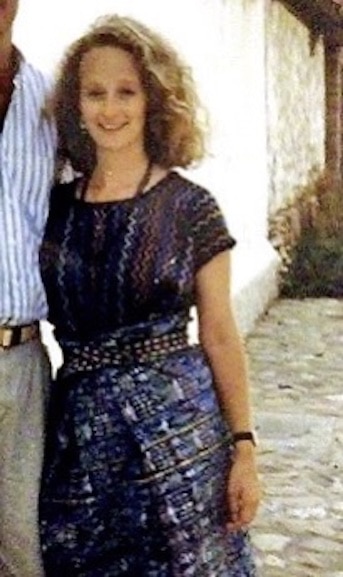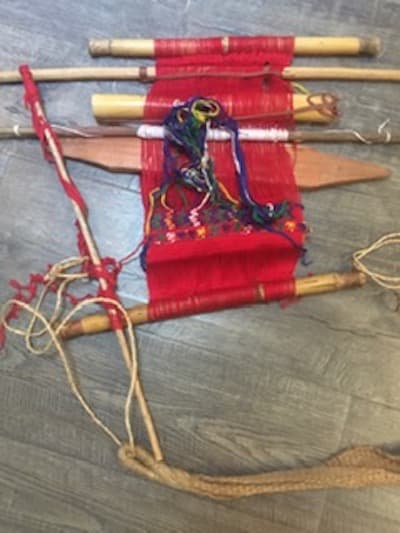Guatemala is a country full of iconic post-card images, from the smoking volcanos, to the colonial era cathedrals of Antigua, to the beautiful Quetzal bird, and the massive stone Mayan temples of Tikal rising above the jungle. As beautiful and familiar as these images are, the most iconic of all is a Mayan woman proudly wearing the huipil (WEE-peel)—a traditional woven blouse worn by indigenous women of Guatemala.
The huipil was the most individualistic piece of a woman’s ensemble. Weavers produced the garments on a backstrap loom as a single panel, then doubled over and sewn up the sides with room for the arms, and a hole cut into the fabric for the head. In addition to the huipil, every Mayan girl would wear a corte (or skirt) from the time she was able to walk.
The author in skirt and blouse
According to Maya traditions, people were taught to spin cotton into yarn and weave fabrics into textiles by Ix Chel, the Mayan moon and earth deity. The goddess is often portrayed in carvings wearing a traditional backstrap loom. Weavers wear the loom around the back and waist, fastened to a tree or similar object. Mayan women consider it their sacred duty to continue the custom of weaving their own clothing as wearable art.
Separated by geography and dialects, more than twenty-five distinct Mayan groups live in Guatemala. As time has passed, each group has customized the huipil, creating gorgeous diversity with colors and patterns. Each town and village invented its own patterns of eagles, spiders, flowers, and other natural themes, sometimes with lace or embroidered edges. Colors are distinctive in each area, so that even when a woman wears a huipil in Guatemala City, it is obvious to all which region she comes from.
Back-strap weavers add their unique touches to the traditional patterns. In our village of San Miguel Chicaj, traditional huipils featured purple, blue and green threads woven into designs representing snakes, interspersed with geometric zigzags. Ladders, busses, autos (and perhaps now, images of cellphones) are occasional depicted in cotton threads. Names of family and friends were sometimes woven into the patterns. Over time, polyester has begun to replace cotton because of its bright colors and the ability to withstand beating against rocks in the river (the usual method of washing clothes in rural Guatemalan villages.)
A Mayan backstrap loom
Weaving on a back-strap loom is a tradition passed from mother to daughter, like other skills such as making tortillas or carrying heavy baskets on one’s head. As I never was able to master carrying baskets or patting out tortillas, I thought that at least I should try my hand at weaving. I sat for long hours on a rush mat in the courtyard of the family compound with Doña Tomasa, one end of the loom strap circled around my back and the other end tied to a tree. Chickens pecked away at my feet while children crept up behind me, having been dared by their cousins to touch my blonde hair.
Doña Tomasa patiently guided my fingers to lift the warp to allow the threads of the weft to create a design. I was sure that she had much more important things to do with her time, but the long hours listening to her speaking in her native Achi language allowed us to discuss a wide variety of topics, such as why Glenn and I didn’t yet have children, or the differences between the American and Guatemalan customs and religions. That we were both using our second language to communicate only added to the humorous miscommunications. Eventually, I produced a small weaving—certainly not enough for a huipil, but enough to satisfy me—even though Doña Tomasa said my weaving looked like it might have been made by a drunken spider.
I cherish this huipil that I wore while Glenn and I were Peace Corps Volunteers in San Miquel Chicaj, Baja Verapaz, Guatemala. It was made by Doña Tomasa, and most certainly does NOT look like the handiwork of a drunken spider.





